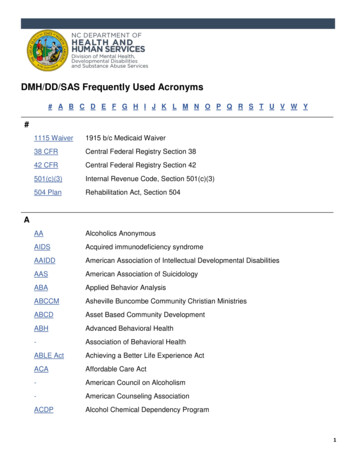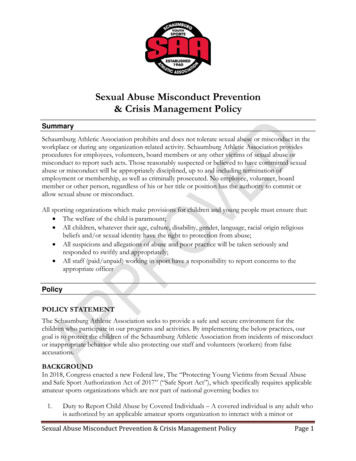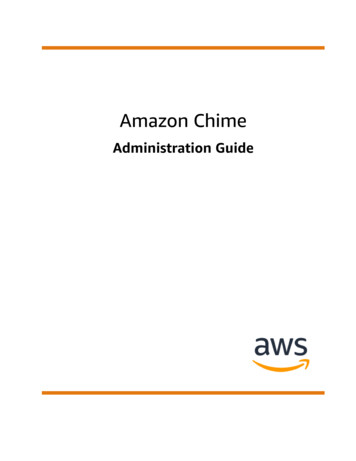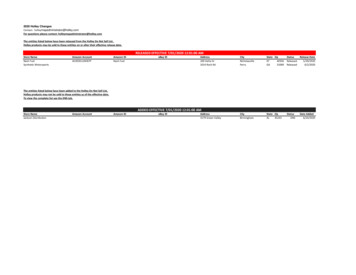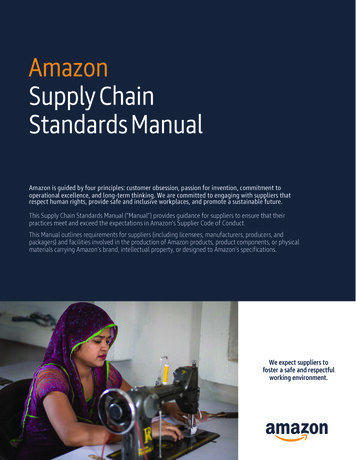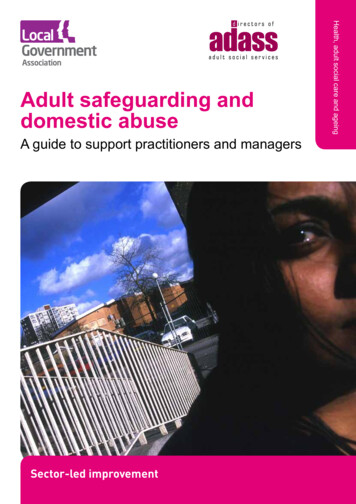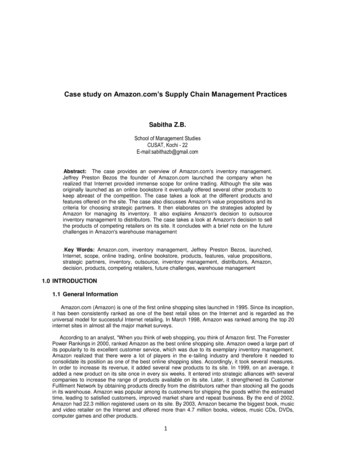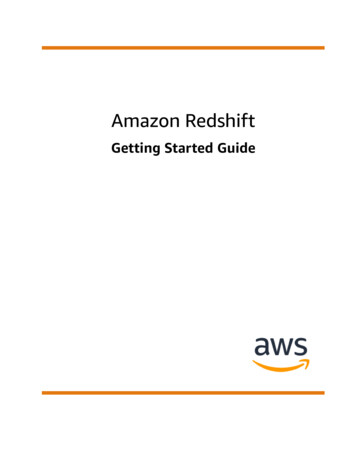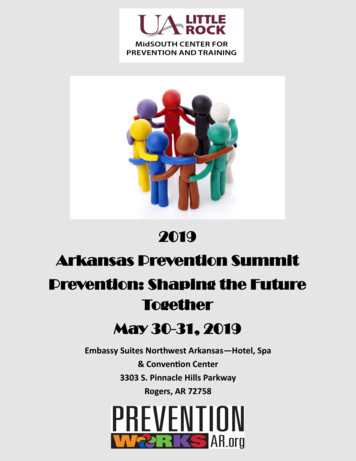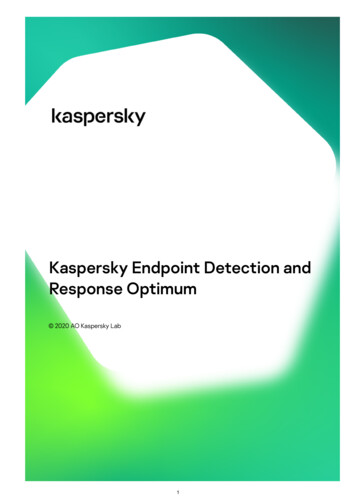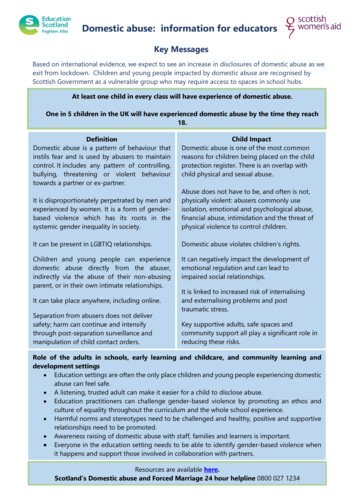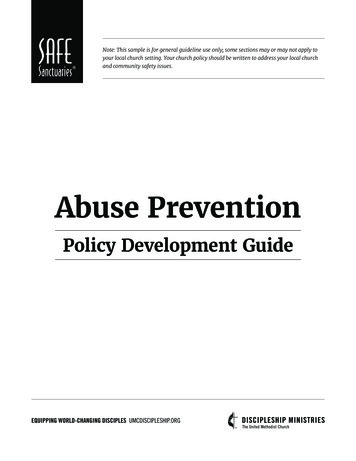
Transcription
Note: This sample is for general guideline use only; some sections may or may not apply toyour local church setting. Your church policy should be written to address your local churchand community safety issues.Abuse PreventionPolicy Development GuideEQUIPPING WORLD-CHANGING DISCIPLES UMCDISCIPLESHIP.ORG
Why Policy Is ImportantGod has called us to make our ministries safe and to protect our children, youth, and other vulnerable peoplefrom abuse and exploitation. God has also called us to create communities of faith where children, youth, andother vulnerable people can be safe and grow strong.Jesus taught that “Whoever welcomes one such child in my name welcomes me” (Mark 9:37 NRSV) and “If anyof you put a stumbling block before one of these little ones it would be better for you if a great millstone werefastened around your neck and you were drowned in the depth of the sea” (Matthew 18:6 NRSV).The Social Principles of The United Methodist Church state, “ children must be protected from economic,physical, and sexual exploitation and abuse” and “we affirm that all persons are individuals of sacred worth,created in the image of God” (¶161, “Social Principles”).At each child’s baptism, we affirm our responsibility to their safety by our congregational response, pledging:“With God’s help, we will so order our lives after the example of Christ, that this child, surrounded by steadfastlove, may be established in the faith, and confirmed and strengthened in the way that leads to life eternal”(From Baptismal Covenant, Congregational Pledge II, The Book of Worship).Building on these foundations, we recognize that our faith calls us to offer hospitality and protection to allchildren, youth, and other vulnerable people, as well as volunteers and employees who are committed toministering with them. Worldwide, child abuse and neglect affect children, youth, and other vulnerable peopleof every age, ethnicity, and economic group. Often, abuse occurs in places where children, youth, and othervulnerable people feel safe—homes, schools, camps, and even churches. According to a U.S. Health and HumanServices recent report, the victim was related to or acquainted with the abuser in more than 90 percent ofcases.1 In light of this, The United Methodist Church and each local United Methodist Church establishespolicies and procedures that:1.lessen the possibility that abuse will happen to children, youth, and other vulnerable people in the church;2.create a place where victims can feel safe in disclosing abuse;3.protect volunteers and employees who minister with children, youth, and other vulnerable people; and4.allow known sexual offenders to safely join in Christian community in the church while protecting thechildren, youth, and other vulnerable people who are a part of our /child-maltreatment-2018SAFE SANCTUARIES: ABUSE PREVENTION POLICY DEVELOPMENT GUIDE2
How to Use This GuideThis guide identifies Safe Sanctuaries policy recommendations to protect children, youth, and other vulnerablepeople; those who share in ministry with them; and known sexual offenders participating as part of ourcongregations. It is recommended that you use the best practices included in each area to update your localchurch’s Safe Sanctuary policy.Annually updating and adopting a policy reflective of current expertise is essential to create safe environmentswhere ministry happens. Effective implementation is vital to protect our ministry participants and reduce ourrisk. Effective policy AND implementation create a respectful, loving setting for ministry.The following Table of Contents will guide your exploration and work as you update or create Safe Sanctuarypolicies for your church. Click on the area you want to explore to go there directly or work your way throughthe entire guide for comprehensive consideration of each aspect that should be included in a complete SafeSanctuaries policy. The headings used in the Table of Contents reflect elements that should be includedin a local church Safe Sanctuary policy. Feel free to use any portion of this guide to build your church’scomprehensive policy. That policy should reflect the unique nature of your congregation, ministry, and setting.Your annual conference ministry protection/risk reduction policies can guide you in creating a final version foryour unique policy.SAFE SANCTUARIES: ABUSE PREVENTION POLICY DEVELOPMENT GUIDE3
Table of Contents05Introduction06Definitions07Selection and Screening of Church Staff and Adult 4Trips and Retreats15Online Safety16Responding to Allegations of Child Abuse18Participation of Known Sexual Offenders19ImplementationAPPENDIX21Appendix I: Child/Youth and Other Vulnerable People Protection Worker Screening Form25Appendix II: Interview Guidelines28Appendix III: Reference Check Response Form30Appendix IV: Authorization And Request For Criminal Records Check31Appendix V: Leader Covenant Statement32Appendix VI: Parental Consent And Medical Authorization34Appendix VII: Child/Youth/Other Vulnerable Person Protection Incident Report36Appendix VIII: Emergency Contact InformationSAFE SANCTUARIES: ABUSE PREVENTION POLICY DEVELOPMENT GUIDE4
IntroductionThe General Conference of The United Methodist Church, in April 1996, adopted a resolution aimed at reducingthe risk of child sexual abuse in the church. The following is a reflection on the adopted resolution Book ofResolutions, 2016 #3084).A central tenet of the Christian faith is the inherent value and worth of all children, youth, and adults.Children, youth, and other vulnerable people are least able to protect themselves in our society and areparticularly vulnerable to abuse and neglect. The United Methodist Church is eager to do all it can to protectthe youth, children, and other vulnerable people who participate in the life of this congregation.We believe implementing a policy and adopting procedures to protect our children, youth, and other vulnerablepeople recognizes that:Our Christian faith calls us to offer both hospitality and protection to our children, youth, and other vulnerablepersons. The Social Principles of the United Methodist Church state, “. . . children must be protected fromeconomic, physical and sexual exploitation and abuse.” The social principles also state, “ all persons areindividuals of sacred worth, created in the image of God.”Tragically, churches have not always been safe places for children, youth, and other vulnerable people. Neglect,sexual abuse, and exploitation occur in churches, both large and small, urban and rural. The problem cutsacross all economic, cultural, racial, and ethnic lines. God calls us to make our churches safe places and toprotect children, youth, and other vulnerable people from abuse.Abuse prevention and ministry protection policies and procedures are essential for congregations, notonly for the protection and safety of our children, youth, and other vulnerable persons, but also for ourvolunteers and staff working with them.The Gospel calls us to be engaged in ministry with children, youth, and other vulnerable persons (SafeSanctuaries: Reducing the Risk of Abuse in the Church for Children and Youth, page 10).Jesus taught, “Whoever welcomes one such child in my name welcomes me” (Mark 9:37 NRSV) and “If any ofyou put a stumbling block before one of these little ones it would be better for you if a great millstone werefastened around your neck and you were drowned in the depth of the sea” (Matthew 18:6 NRSV).We should not allow possible risks to undermine or stop our ministry. Rather, we must: Acknowledge the risks and develop a practical plan to address these issues: Take steps to prevent harm to our children, youth, and other vulnerable persons; and Continue to answer the Gospel’s imperative to be in ministry with children, youth, and othervulnerable persons, thus making a difference in their lives (adapted from Safe Sanctuaries: Reducing theRisk of Abuse in the Church for Children and Youth, page 10. Safe Sanctuaries policies and the implementation of practices that reflect those policies seek to fulfillthis call for our church.SAFE SANCTUARIES: ABUSE PREVENTION POLICY DEVELOPMENT GUIDE5
DefinitionsA common set of definitions provides a useful frame of reference for policy development. Churches may haveterms specific to their ministry situation indicating the need to modify those listed here or creating their ownset of definitions.Child: In the United States, this term is commonlyYouth helpers: People under the age of eighteenused to identify anyone age eleven or younger.who are assisting with child or youth activities.They can assist with activities but should not beYouth: Anyone not a “child” and under the age ofconsidered adult volunteers and should always beeighteen (age of legal majority).supervised. Youth helpers should be at least threeyears older than the children or youth they areAdult: Anyone who has reached the age of legalhelping. A youth helper will normally be consideredmajority and has finished high school.“unscreened.”Vulnerable person: A person whose ability to protectRoamer: A Safe Sanctuaries trained/screened adulthimself/herself from violence, abuse, or neglect isleader who meets the minimum age requirementssignificantly impaired through social, physical, oras defined in this policy and moves throughoutmental disability or illness.the facility to provide additional oversight andsupervision during activities.Paid staff person: Someone paid by the church,overseen by the staff/pastor parish relationsMinistry supervisor: A screened individual, staff orcommittee, and screened according to the church’svolunteer, responsible for a particular ministry withSafe Sanctuary policy and any additional requiredoversight of the leaders in that ministry.personnel screening.Physical abuse: Violent, non-accidental contact thatUnscreened adult: Someone who has not beenresults in injury. This includes, but is not limited to,screened. The individual may work in a room withstriking, biting, or shaking. Injuries include bruises,a screened adult or screened paid staff person. Hefractures, cuts, and burns.or she should never be alone with children, youth,or other vulnerable people. Unscreened adults maySexual abuse: Any form of sexual activity with aor may not be church members, but they must bechild/youth/other vulnerable person, whether at theregular attendees and active in the church for atchurch, at home, or any other setting. The abuserleast six months. Use of unscreened adults shouldmay be an adult or another minor.be exceptions rather than normal practice. Rareexceptions may be made in consultation with the pastorEmotional abuse: A pattern of intentional conductin charge in special situations.that crushes a child’s/youth’s/other vulnerableperson’s spirit and attacks his/her self-worthScreened adult: A volunteer who has gone throughthrough rejection, threats, terrorizing, isolating, orthe screening process involving a criminalbelittling.background check, reference check, interview, andrisk reduction training. These people may or mayNeglect: When a person with responsibility for anot be members, but they must be regular attendeeschild, youth, or other vulnerable person fails toand active in the church for at least six months.care for that individual’s physical and/or emotionalneeds.SAFE SANCTUARIES: ABUSE PREVENTION POLICY DEVELOPMENT GUIDE6
Selection and Screening of Church Staffand Adult VolunteersA. The pastor in charge or his/her designee and the staff parish relations committee are charged with theresponsibility of developing, implementing, and evaluating the process for recruiting, screening, selecting,training and supervising non-appointive church staff (¶ 258.12 Book of Discipline, 2016).B. All adults who regularly work with the church’s children, youth, and other vulnerable people, and eachchurch paid staff person, including clergy, will be screened. Adults who occasionally serve as a secondperson in a classroom or group and those who work regularly with children/youth/other vulnerable peoplewill be trained on child/youth/other vulnerable people’s protection issues prior to beginning their regularinvolvement with these people.C.Screening Procedures1.Each person being considered to work regularly with children, youth, and/or other vulnerable people,whether as a volunteer or paid staff person, shall fill out a CHILD/YOUTH and OTHER VULNERABLEPEOPLE WORKER SCREENING FORM (See Appendix I). This screening form is good for three years,after which time a rescreening will be necessary.2.Before placing the applicant in a position of responsibility with children, youth, or other vulnerablepeople, a designated paid staff member or person charged with specific responsibility will interview theapplicant and review the written application. (See INTERVIEW GUIDE for possible questions, AppendixII.)3.Child Abuse Survivor ApplicantsAdult survivors of childhood physical or sexual abuse need the love and acceptance of this churchfamily. A person’s experience with abuse and the recovery process may be pertinent to the individual’ssuitability as a youth, children’s or other vulnerable people’s ministry worker. Applicants who aresurvivors of abuse should discuss this in confidence with the person who conducts the confidentialinterview. If an applicant is uncomfortable doing so, he/she may have the interview conducted by apastor.When evaluating candidates, the following factors will be considered if an applicant is a survivor ofchild abuse:A. whether the applicant has previously committed an act of child abuse or molestation (anyonewho has maltreated children may not serve in ministry with children, youth, or other vulnerablepeople);B. the extent of professional counseling the applicant has received;C.the opinion of references, especially professional counselors who have served the applicant;SAFE SANCTUARIES: ABUSE PREVENTION POLICY DEVELOPMENT GUIDE7
D. the opinion of leaders in other churches or youth organizations in which the applicant has beeninvolved; how closely the church is able to supervise and monitor the position for which theapplicant is applying.4.The person conducting this interview will contact the references provided on the screening form andany additional people as the circumstances dictate. A written record of such contacts will be retainedwith the screening form. (See REFERENCE CHECK RESPONSE FORM, Appendix III).*5.Each person applying to work with children, youth, and/or other vulnerable people shall authorize thechurch to conduct a criminal background check. Recommended checks to be included:a.County-level/multi-county seven-year searchb.National criminal background checkc.National Sex Offender RegistryUsing at least these checks will provide the most comprehensive information. You must get writtenauthorization to run a background check. For people who have not lived in state for at least fiveyears, a national background check/multi-county seven-year search needs to be conducted for eachaddress given by the applicant. (See AUTHORIZATION AND REQUEST FOR CRIMINAL RECORDS CHECK,Appendix IV).*Before beginning work with children, youth, or other vulnerable people, each paid staff member andvolunteer will sign a form stating that he/she has read, understood, and agrees to abide by this Child,Youth, and Other Vulnerable People Protection Policy. (See LEADER COVENANT, Appendix V)D. After the interview and background check have been accomplished, the decision will be made to approveor not approve the applicant as a paid staff member or screened adult who will work with youth, children,and/or other vulnerable people.E.Where it has been determined that an applicant should not be approved, those people involved with thedecision should handle it in a sensitive manner. The pastor in charge or her/his designee should inform theapplicant in person. The specific reasons for the decision should be given, whenever possible.*F.It is important that all records be kept in a locked cabinet in the pastor in charge’s office. There should bea system in place that offers those who need these records appropriate access and a safe place to be storedto assure confidentiality.*G. Although not required to accomplish the above tasks personally, the pastor in charge shall be responsiblefor ensuring compliance with sub-paragraphs (A) through (F) above.* A number of companies offer online platforms for this process. Some annual conferences have partnered with onlineplatforms and service providers to aid in administration and training. This can increase consistency, provide support whereadequate local staffing is not available, and simplify process and record keeping. The steps identified with an “*” wouldbe handled differently in consultation with the platform provider. Please click here to find information about providerscurrently used by United Methodist annual conferences.SAFE SANCTUARIES: ABUSE PREVENTION POLICY DEVELOPMENT GUIDE8
TrainingThe pastor in charge or designee and staff parish relations committee shall ensure that regularly scheduled(i.e., at least annual) training focused on foundational and current issues of child protection is available toand received by those working with children, youth, and other vulnerable people. Attendance at this trainingshall be required prior to involvement in affected areas of ministry by all paid staff members, screened andunscreened adults, and youth helpers who work consistently with children, youth, and/or other vulnerablepeople.The training should include*:A. The definition and recognition of child abuse. (See “Definitions” above)B. The church’s policy and procedures on child abuse and the reasons for having them.C.The need to maintain a positive classroom environment, including appropriate discipline and age-levelcharacteristics.D. The appropriate behavior for teachers and leaders of child/youth events as well as all events includingvulnerable people.E.Abuse reporting responsibilities and procedures.F.Definition of appropriate interpersonal boundaries.NOTE: A Training Model is included in “Safe Sanctuaries: Reducing the Risk of Abuse in the Church for Children andYouth,” p. 125.*If your church uses an online platform for training through a company offering this service, review the training andensure a supplemental local session is held to educate ministry leaders on topics/issues unique to your ministry setting.While online training can provide convenience and consistency for your staff and volunteers, a local session affirms yourleaders and the importance of Safe Sanctuaries for your congregation.SAFE SANCTUARIES: ABUSE PREVENTION POLICY DEVELOPMENT GUIDE9
SupervisionGeneral1.All activities involving children, youth, and other vulnerable people will be supervised by at least onescreened adult and will have at least two leaders present. A designated roamer shall monitor the roomwhen it is not possible to have two leaders present or when one leader is not screened.2.When reasonably feasible, each room set aside for children/youth should have a door with a window.(Windows in doors tend to remove the opportunities for secrecy and isolation, conditions every childabuser seeks.) Half doors should be considered for toddlers to second-grade children to keep them fromwandering outside the classroom. Windows should remain free from obstruction; avoid covering them. Ifthere are no windows in the door, the door should remain open.3.The “two-person rule” is defined as having at least two unrelated people in any classroom or setting,at least one of which must be a screened adult volunteer or staff person. When the two adults are familymembers, it is preferable that a third adult be present. When this is not possible, a designated roamershould visit the room regularly. If using a roamer, keep doors open.Classroom Activities1.Crib/Toddler to Second GradeAt least one screened adult and a second unscreened adult will be present for all classroom activitiesinvolving infants, toddlers, and children in grades K-2. When feasible, there should be two screened adultspresent; and when the two adults are family members, it is preferable that a third adult be present. Inaddition, a designated roamer should check each classroom on a regular basis. Two adult leaders in theclassroom is the expectation; at least one of them must be a screened adult.2.Grades 3–5At least one screened adult and a second adult volunteer will be present for all classroom activities. Twoscreened adults are preferred. In addition, a designated roamer should check each classroom on a regularbasis. Children should be escorted to and from bathroom facilities or when otherwise leaving the roomby either one of the adults or by a designated roamer who checks on all classrooms. Where two adults arenot available, the classroom doors are to remain open, and a designated roamer should visit the classroomregularly.3.Grades 6–12Classroom activities will be led by at least one screened adult with at least two leaders present. Adesignated roamer shall monitor the room when it is not possible to have two leaders present or if oneleader is not screened.Open Door PolicyParents, volunteers, or staff of the church will be permitted, as reasonableness dictates, to visit and observe allprograms and classrooms at any time.SAFE SANCTUARIES: ABUSE PREVENTION POLICY DEVELOPMENT GUIDE10
Sign-in/Sign-out ProcedureAdults responsible for children who are infants through toddlers should sign their children in and indicatethe names of authorized person(s) to whom the child may be signed out. Adults responsible for children age 2through second grade should sign their child in and out of Sunday school and other children’s activities. Avoidnonauthorized adults picking up children. Older siblings, parents, and other adults may be authorized to pickup children when they are identified on a child’s care and information records. This record of authorized adultswith pick up privileges should be updated annually.Supervision of Non-Classroom ActivitiesAt least two screened adults will be present for all non-classroom activities involving children, youth, and/orother vulnerable people. Any meetings held in an individual’s home will be supervised by at least one screenedadult, with two adults present who are not members of the same family. Meetings held in an individual’s homemust be pre-approved by the child’s/youth’s/vulnerable person’s parent or guardian.Counseling of Youth, Children, and Other Vulnerable PeopleIn instances where circumstances dictate that counseling would be most effective on a one-on-one basis, anappropriate paid church staff person may meet individually for one-on-one conversations with the knowledgeof at least one other paid staff member and with permission of a parent or guardian. During any one-on-oneconversation with children, youth, or other vulnerable people, the door of the room used should remain openfor the entire session, unless there is glass in the door or wall that gives a clear view into the room. If anotheradult is not in the building when the counseling occurs, the session should be moved to a public place, such asa restaurant or outside where other people are present.NOTE 1: At the initial meeting, the adult should first determine if he/she is qualified to address the child’s/youth’s/othervulnerable person’s needs effectively. Counseling should be limited to no more than three sessions. Referral to anothermore qualified counselor should always be considered.NOTE 2: This section is not meant to govern a licensed professional counselor in a paid counseling relationship with a child,youth, or other vulnerable person.Time Following Group EventsFollowing group events, it is inevitable that occasionally a child’s/youth’s/or other vulnerable person’stransportation arrives after all other participants have departed. Two screened leaders should be scheduled tobe present until all participants have been picked up. In some circumstances, a child/youth/ other vulnerableperson may unavoidably be supervised by one screened adult. When this occurs, the screened adult isresponsible for exercising his/her best judgment for the participant’s well-being as well as his/her own.Example—Have the parents on the phone with you until they arrive.SAFE SANCTUARIES: ABUSE PREVENTION POLICY DEVELOPMENT GUIDE11
TransportationGeneral RulesTransporting children, youth, and other vulnerable people is an important concern. Their safety can be atrisk in a variety of ways. Therefore, certain discretion must be used depending upon the event attended, thelocale of the event, and the age group participating. This policy includes both requirements and guidelines.When feasible, there should be adherence to the recommendations and the guidelines. It is expected that therequirements will always be followed.Requirements1.Drivers must be known to the designated screened adult leader of the event.2.When a child/youth/other vulnerable person is transported in any vehicle, the driver must be either thechild’s/youth’s/other vulnerable person’s parent/guardian, a screened adult, or a paid staff person who isat least 21 years old.3.When a child/youth/other vulnerable person is transported in a church-owned vehicle, the driver mustbe at least 21 years of age; an exception is made when the driver is a paid staff member who is at least 18years of age and for whom a motor vehicle record search has been made and the record has been foundto be satisfactory by the pastor in charge or his/her designee. (This is subject to other church policy, statelaw, and insurance regulations.)4.Drivers must have a valid driver’s license for the vehicle being operated. For example, if driving a church bus, acommercial driver’s license is required. A copy of the driver’s license should be on file in the church office.5.Drivers must require that passengers wear seat belts; the number of passengers must not exceed thenumber of seat belts.6. Drivers should be advised of a designated route and should not deviate from it except in cases ofemergency or road detours.7.Drivers should not use cell phones unless required for communication with other drivers. Any use shouldbe hands-free and in accordance with state law. Drivers should not text/message while driving.8.When there is reason to believe it would not be safe for a youth to ride in a vehicle driven by another youth,the adults responsible should intervene and take reasonable steps to make alternative arrangements for allconcerned.9. When a trip is planned and the destination is expected to be 100 miles or more from the point of departure,drivers are to be listed on an “approved driver list” maintained in the church office.10. People who regularly drive church-owned vehicles are to be listed on an “approved driver list” maintainedin the church office.SAFE SANCTUARIES: ABUSE PREVENTION POLICY DEVELOPMENT GUIDE12
11. To be listed on the “approved driver list,” a motor vehicle record search must have been conducted, andthe pastor in charge or his/her designee must determine if the record is satisfactory.12. Drivers will read and sign an acknowledgement form indicating that the Child, Youth, and Other VulnerablePeople Protection Policy has been read and will be followed (See Appendix V).Guidelines1.Drivers should be accompanied by at least one other adult and more than one youth.2.Drivers should receive training for any church-owned vehicle being operated.3.Youth who drive their own vehicles should be reminded regularly of the importance of vehicle safety.4.Any use of a ride-share service should be scheduled by a parent or guardian and drop-off/pickup confirmedby the parent/guardian with the adult in charge of a specific event or activity.SAFE SANCTUARIES: ABUSE PREVENTION POLICY DEVELOPMENT GUIDE13
Trips and RetreatsTrip and retreat settings can call for different child/youth/other vulnerable people protection requirements,depending on the circumstances. What follows are requirements and guidelines of this policy. Therequirements should always be implemented. Depending on the circumstances of the setting, who is inattendance, etc., some or all of the guidelines should be implemented as needed. Those in charge of the trip orretreat should be mindful of both requirements and guidelines, in addition to applying their own wisdom to theneeds of a given occasion.Requirements1.There will be at least two screened adults present for all trips, retreats, and other events where thechildren, youth, and /or other vulnerable people gather overnight at, or away from, the church campus.2.There will be at least one screened adult for each gender present at coed overnight events. At singlegender overnight events, at least one of the two screened adults present shall be of the same gender as thechildren/youth/other vulnerable people who are present.3.The person in charge of youth/children/other vulnerable people for each overnight trip and/or retreat shallcarry parental permission forms, including permission for emergency medical care. (See Appendix VI)Guidelines in a hotel type setting; rooms should be assigned as follows:1.Separate rooms for adults and child/youth/other vulnerable people (where applicable) should be assignedwith at least two participants per room except where specific situations dictate a different arrangement.2.Assignments should be made so that an adult room is between two children’s/youth’s/other vulnerableperson’s rooms.3.Adults should make random monitoring hall trips and room checks at night. This should be done by twoadults of the same gender as those being checked.4.A hotel should be selected where the rooms open to the interior of the building (i.e., do not open to theoutside).SAFE SANCTUARIES: ABUSE PREVENTION POLICY DEVELOPMENT GUIDE14
Online SafetyThe use of electronics or media
child/youth/other vulnerable person, whether at the church, at home, or any other setting. The abuser may be an adult or another minor. Emotional abuse: A pattern of intentional conduct that crushes a child’s/youth’s/other vulnerable person’s spirit and attacks his/her self-worth t
